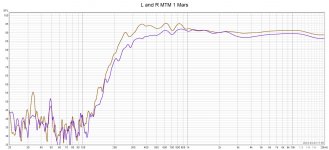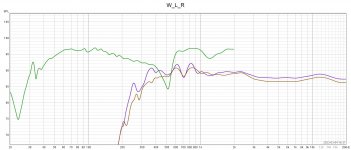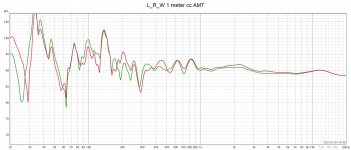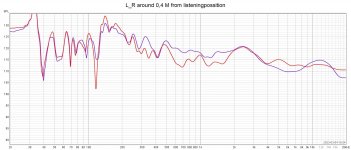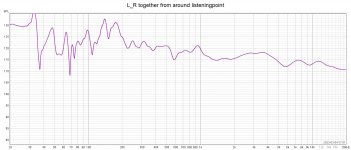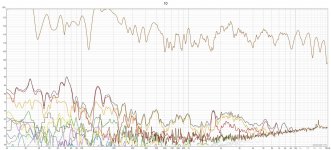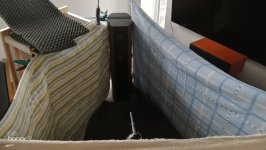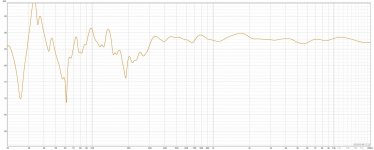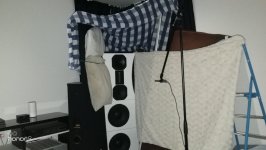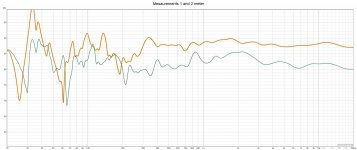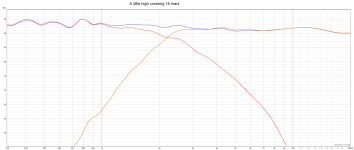Are finetuning my MTM passive xover in the current room and in the actual baffle.
The midranges are Audax HM210Z10 in about 16 liter each and the tweeter is a Mundorf AMT29CM1.1
Xover-points are around 340 and 1900 hz ( have active filter for woofers under 340 hz)
Have made 2 different xovers with slightly different values on both coils and capacitors, & both with & without resistors.
I think it´s so hard to judge the result when you listening in mono, and old amps often have "balance-button" so you can go from right to left easy but mine haven´t.
So i have to connect one MTM at the time, and go to the speaker and disconnect and connect the other to shift.....Not good!
And feels that it makes it more difficult because my MTM works from 340 hz.
I'm hoping for some advice on two aspects of this process.
The first is simply this: What do you listen for when you've put together a new DIY passive xover?
For example, do you listen to the speakers separately or together?
And how are you looking for ways to refine the result?
With woofers connected or not?
In "sweetspot-sofa" or right in front of the speaker?
Have you a favorite curve, and how does it look like ?
For an exemple i post a pic on the 2 different passive xovers mesaurements (that i listening on), but so hard to analyze/judge the sound i think
Best regards John/Sweden
The midranges are Audax HM210Z10 in about 16 liter each and the tweeter is a Mundorf AMT29CM1.1
Xover-points are around 340 and 1900 hz ( have active filter for woofers under 340 hz)
Have made 2 different xovers with slightly different values on both coils and capacitors, & both with & without resistors.
I think it´s so hard to judge the result when you listening in mono, and old amps often have "balance-button" so you can go from right to left easy but mine haven´t.
So i have to connect one MTM at the time, and go to the speaker and disconnect and connect the other to shift.....Not good!
And feels that it makes it more difficult because my MTM works from 340 hz.
I'm hoping for some advice on two aspects of this process.
The first is simply this: What do you listen for when you've put together a new DIY passive xover?
For example, do you listen to the speakers separately or together?
And how are you looking for ways to refine the result?
With woofers connected or not?
In "sweetspot-sofa" or right in front of the speaker?
Have you a favorite curve, and how does it look like ?
For an exemple i post a pic on the 2 different passive xovers mesaurements (that i listening on), but so hard to analyze/judge the sound i think
Best regards John/Sweden
Attachments
My normal process is to start with one speaker.
If you're just doing a basic listen/measurement run, you can omit the woofers, but it's harder to judge things by ear that way. If there's a glaring issue, you'll hear it/see it though. For basic measurements, you can normally do them at 1-2 meters, with the typical caveat that large speakers or those with shallow crossovers may need to be measured closer to the intended listening distance (typically 2-3 meters).
I have a standard test box I use for bass if I'm just working on midranges/tweeters, but want to listen to something more like the finished unit. An active crossover and extra amp are also handy to deal with this.
For actually balancing/voicing the speaker, you need to listen to something full range (whatever that means in your application) and in a typical room with the intended placement. I normally place the test speaker right next to my everyday speakers (that are well reviewed and well balanced, so I know what they're doing at that spot in the room should be the basic goal). I'll run RTA and long windowed impulse-based measurements with the microphone at the listening spot to compare the two speakers and do basic adjustments. Then I listen a bit, and adjust some more. I also compare the new speaker to a set of closed headphones/earphones that are also known to be well-balanced, so I can instantly compare back and forth. Adjust some more. This tends to span multiple days. In long sessions, your ears get tired and you start to lose your ability to judge things accurately.
Once that's dialed in reasonably close and I'm happy with it, I'll build the second speaker and go through the headphone/reference speaker adjustment process again and listen more extensively across multiple days with every kind of music I typically listen to.
This whole process typically leads to multiple small adjustments in the crossover.
If you're just doing a basic listen/measurement run, you can omit the woofers, but it's harder to judge things by ear that way. If there's a glaring issue, you'll hear it/see it though. For basic measurements, you can normally do them at 1-2 meters, with the typical caveat that large speakers or those with shallow crossovers may need to be measured closer to the intended listening distance (typically 2-3 meters).
I have a standard test box I use for bass if I'm just working on midranges/tweeters, but want to listen to something more like the finished unit. An active crossover and extra amp are also handy to deal with this.
For actually balancing/voicing the speaker, you need to listen to something full range (whatever that means in your application) and in a typical room with the intended placement. I normally place the test speaker right next to my everyday speakers (that are well reviewed and well balanced, so I know what they're doing at that spot in the room should be the basic goal). I'll run RTA and long windowed impulse-based measurements with the microphone at the listening spot to compare the two speakers and do basic adjustments. Then I listen a bit, and adjust some more. I also compare the new speaker to a set of closed headphones/earphones that are also known to be well-balanced, so I can instantly compare back and forth. Adjust some more. This tends to span multiple days. In long sessions, your ears get tired and you start to lose your ability to judge things accurately.
Once that's dialed in reasonably close and I'm happy with it, I'll build the second speaker and go through the headphone/reference speaker adjustment process again and listen more extensively across multiple days with every kind of music I typically listen to.
This whole process typically leads to multiple small adjustments in the crossover.
Last edited:
A crossover is supposed to take into account the acoustic nature of the speaker, and this is supposed to be addressing the room to some degree, and you will find the appropriate compromises to deal with the remaining room issues.
If you've designed the physical configuration of your speaker without considering how it will help to work in your room, then you may need to become accustomed to the result to some degree.
If you've designed the physical configuration of your speaker without considering how it will help to work in your room, then you may need to become accustomed to the result to some degree.
Thorough, professional answers above.
My amateur low-tech way:
https://www.diyaudio.com/community/threads/replacing-crossover-capacitors.392208/post-7177613
It helps to confirm (by ear) first, speaker pointing axially at the ear from front L/R and playing tone-sweep slowly through the XO region, that (1) combined response is flat, and (2) by moving one driver back-and-forth to locate the combined-response periodic maxima, that the drivers mounted-on-baffle are in phase at the XO frequency.
My amateur low-tech way:
https://www.diyaudio.com/community/threads/replacing-crossover-capacitors.392208/post-7177613
It helps to confirm (by ear) first, speaker pointing axially at the ear from front L/R and playing tone-sweep slowly through the XO region, that (1) combined response is flat, and (2) by moving one driver back-and-forth to locate the combined-response periodic maxima, that the drivers mounted-on-baffle are in phase at the XO frequency.
My normal process is to start with one speaker.
If you're just doing a basic listen/measurement run, you can omit the woofers, but it's harder to judge things by ear that way. If there's a glaring issue, you'll hear it/see it though. For basic measurements, you can normally do them at 1-2 meters, with the typical caveat that large speakers or those with shallow crossovers may need to be measured closer to the intended listening distance (typically 2-3 meters).
I have a standard test box I use for bass if I'm just working on midranges/tweeters, but want to listen to something more like the finished unit. An active crossover and extra amp are also handy to deal with this.
For actually balancing/voicing the speaker, you need to listen to something full range (whatever that means in your application) and in a typical room with the intended placement. I normally place the test speaker right next to my everyday speakers (that are well reviewed and well balanced, so I know what they're doing at that spot in the room should be the basic goal). I'll run RTA and long windowed impulse-based measurements with the microphone at the listening spot to compare the two speakers and do basic adjustments. Then I listen a bit, and adjust some more. I also compare the new speaker to a set of closed headphones/earphones that are also known to be well-balanced, so I can instantly compare back and forth. Adjust some more. This tends to span multiple days. In long sessions, your ears get tired and you start to lose your ability to judge things accurately.
Once that's dialed in reasonably close and I'm happy with it, I'll build the second speaker and go through the headphone/reference speaker adjustment process again and listen more extensively across multiple days with every kind of music I typically listen to.
This whole process typically leads to multiple small adjustments in the crossover.
Thanks for your commitment.
The hardest i fell is just to judge the sound by ONE speaker in mono, and from 340 hz and up make it even more difficult.
I have tried both without and with bass, but still superhard to judge, and think it sounds so thin in general with one mono to judge.
Sadly i don´t have a "everyday speaker" in that room in the basement to compare with.
My dedicated stereo/cinema room is in the basement and measures 5 x 10 meters, but i have a broken back and neck so i can´t carry the 60 kilo Genesis 5.1 how sits in my livingroom upstairs.
Your words "your ears get tired and you start to lose your ability to judge" is very true.
Have you a typical mesaurementcurve that you like, and how does that curve look?
A crossover is supposed to take into account the acoustic nature of the speaker, and this is supposed to be addressing the room to some degree, and you will find the appropriate compromises to deal with the remaining room issues.
If you've designed the physical configuration of your speaker without considering how it will help to work in your room, then you may need to become accustomed to the result to some degree.
Thank you Allen
Can you explain more what you mean with "acoustic nature of the speaker" ?
And yes, I am an insufficiently trained loudspeaker builder, who always chooses drivers based on those I previously liked or read well about,
and important factors are that drivers have higher sensitivity and can withstand sufficient power.
From that i try to make a "nice looking speaker" ( i was a carpenter )
And my room is 5 meter wide and also treated ( and to-in placed speakers), so frequencies above about 300 are usually not a "problem" which the room creates.
And how does your favorite mesaurementcurve look like ?
Thorough, professional answers above.
My amateur low-tech way:
https://www.diyaudio.com/community/threads/replacing-crossover-capacitors.392208/post-7177613
It helps to confirm (by ear) first, speaker pointing axially at the ear from front L/R and playing tone-sweep slowly through the XO region, that (1) combined response is flat, and (2) by moving one driver back-and-forth to locate the combined-response periodic maxima, that the drivers mounted-on-baffle are in phase at the XO frequency.
Thank you wchang
I will try with "playing tone-sweep slowly" and read your link.
Best regards John
If you only want to judge a restricted frequency range, your reference could also be filtered to the same range (filter your headphone output to have the same roll-off as your midrange/tweeter box). But it's still harder to judge things this way since you are listening to something with an unnatural frequency balance.
If you have the funds and are serious about speaker work, picking up something like the KEF LS50 might be useful. They're smallish but well regarded. That would be easier to move around. Having test gear on a roll-around cart is also good. That lets you more easily move extra amps, source, preamp, active crossover, and measurement PC.
Many will not have the funds, space, or commitment for the above, so a good pair of closed-back headphones or in-ear noise isolating earphones can be a really good reference tool also. There are lots of headphones that are not neutral though, so you have to choose carefully. Shure E2C's were an economical route to this previously, but they're discontinued and I'm not familiar with their newer models. They also have to fit properly to achieve their potential. Obviously imaging/soundstaging are completely different with headphones, but for frequency balance they are very helpful.
I agree, judging one speaker is different than a pair. In my experience this is mostly about bass balance though. If you have that portion on a separate amp with a gain control, that's easy to balance to taste. If you are fine tuning, L vs R differences in recordings can be a source of a little confusion with one speaker. And this does still need to be done in a normal listening position for you and the speaker. Trying to balance a speaker in a weird spot in a random room does not normally work well.
The one vs. two speaker issue is also why I typically have to rebalance things when the pair of speakers is used. It is more work in tuning, but less work in building things I may not like enough to justify the second speaker.
My typical 1/3 octave-based RTA target for in-room response with pink noise is a gentle downward slope with increasing frequency. -2.5 dB from 100 Hz to 10 kHz is a decent starting point, but it's a matter of taste and can be influenced by the speaker. Many listeners find a flat in-room response bright. A dip of a couple dB in the 4 kHz region can also help lessen listening fatigue, but again that's personal preference.
If you have the funds and are serious about speaker work, picking up something like the KEF LS50 might be useful. They're smallish but well regarded. That would be easier to move around. Having test gear on a roll-around cart is also good. That lets you more easily move extra amps, source, preamp, active crossover, and measurement PC.
Many will not have the funds, space, or commitment for the above, so a good pair of closed-back headphones or in-ear noise isolating earphones can be a really good reference tool also. There are lots of headphones that are not neutral though, so you have to choose carefully. Shure E2C's were an economical route to this previously, but they're discontinued and I'm not familiar with their newer models. They also have to fit properly to achieve their potential. Obviously imaging/soundstaging are completely different with headphones, but for frequency balance they are very helpful.
I agree, judging one speaker is different than a pair. In my experience this is mostly about bass balance though. If you have that portion on a separate amp with a gain control, that's easy to balance to taste. If you are fine tuning, L vs R differences in recordings can be a source of a little confusion with one speaker. And this does still need to be done in a normal listening position for you and the speaker. Trying to balance a speaker in a weird spot in a random room does not normally work well.
The one vs. two speaker issue is also why I typically have to rebalance things when the pair of speakers is used. It is more work in tuning, but less work in building things I may not like enough to justify the second speaker.
My typical 1/3 octave-based RTA target for in-room response with pink noise is a gentle downward slope with increasing frequency. -2.5 dB from 100 Hz to 10 kHz is a decent starting point, but it's a matter of taste and can be influenced by the speaker. Many listeners find a flat in-room response bright. A dip of a couple dB in the 4 kHz region can also help lessen listening fatigue, but again that's personal preference.
Last edited:
One way to describe it would be by starting with the measurement of the direct sound and saying that acoustic considerations take in all the rest of the sound. The most of it in fact.. and after you balance your direct sound, the amount of other sound varies by frequency, but it's not only the amount but where it goes, and how long we wait before hearing it.Can you explain more what you mean with "acoustic nature of the speaker" ?
I'm not suggesting you need to address all these things right now and I'm not saying you can't make a good speaker unless you do. However there are some important things to realise.
One is that there is not much sense expecting a flat response to work. If you haven't mastered the first paragraph then you'll be making adjustments by ear. No problem, just keep an open mind and remember that you may be working against multiple unrelated problems that have an impact on your target voicing.
The other is that if you feel confused looking at response curves thinking they don't obviously tell you anything, that's because most of the time that's correct.
If you only want to judge a restricted frequency range, your reference could also be filtered to the same range (filter your headphone output to have the same roll-off as your midrange/tweeter box). But it's still harder to judge things this way since you are listening to something with an unnatural frequency balance.
If you have the funds and are serious about speaker work, picking up something like the KEF LS50 might be useful. They're smallish but well regarded. That would be easier to move around. Having test gear on a roll-around cart is also good. That lets you more easily move extra amps, source, preamp, active crossover, and measurement PC.
Many will not have the funds, space, or commitment for the above, so a good pair of closed-back headphones or in-ear noise isolating earphones can be a really good reference tool also. There are lots of headphones that are not neutral though, so you have to choose carefully. Shure E2C's were an economical route to this previously, but they're discontinued and I'm not familiar with their newer models. They also have to fit properly to achieve their potential. Obviously imaging/soundstaging are completely different with headphones, but for frequency balance they are very helpful.
I agree, judging one speaker is different than a pair. In my experience this is mostly about bass balance though. If you have that portion on a separate amp with a gain control, that's easy to balance to taste. If you are fine tuning, L vs R differences in recordings can be a source of a little confusion with one speaker. And this does still need to be done in a normal listening position for you and the speaker. Trying to balance a speaker in a weird spot in a random room does not normally work well.
The one vs. two speaker issue is also why I typically have to rebalance things when the pair of speakers is used. It is more work in tuning, but less work in building things I may not like enough to justify the second speaker.
My typical 1/3 octave-based RTA target for in-room response with pink noise is a gentle downward slope with increasing frequency. -2.5 dB from 100 Hz to 10 kHz is a decent starting point, but it's a matter of taste and can be influenced by the speaker. Many listeners find a flat in-room response bright. A dip of a couple dB in the 4 kHz region can also help lessen listening fatigue, but again that's personal preference.
Once again thanks for you rich in content answer.
One big problem is that my favorite speaker which I used & loved for 20 years, and which was my absolute reference.
I have a long time hifi friend living 550 km from me and he is handicapped, and can only move his head and his right arm a little after a caraccident 30 years ago.
He has been pestering me for years that he wants to trade his Genesis 5.1's for my upgraded Von Schweikert VR4 to VR 5-7, because he wants to change a little in his setup. ( ivé helpt him with cd-player, preamp, amp´s etc )
So last 2-3 years when i more and more begain to build my own diy-speakers ( mostley for my newer big room was to big for the Von Schweikert speakers), so I've started to think that maybe I should agree to his wish because I don't use them that much anymore.
So i did the switch 15 month ago, and 2 month later I bought a microphone and started my journey taking measurements.
So i haven´t mine reference speaker anymore, as I knew everything about how music should sound.
I never got into headphones either ( exept sony freestyle around 1980), because I feel that the ear is injured by sounds so close to our eardrum, & especially for me who always listens loudly.
And i can´t afford to buy any new KEF LS50's, & I don't think it would help me much as it would mean a "new sound" for me that I'm not familiar with.
I can increase bass +6 dB with a gain control, but my MTM combo is att 101 dB sensitivety, so hard to get bass "in total balance".
Perfekt info about your " -2.5 dB from 100 Hz to 10 kHz is a decent starting point" and " Many listeners find a flat in-room response bright. A dip of a couple dB in the 4 kHz region can also help lessen listening fatigue" 👍
In my ears i think a flat-in-room responce most often sounds a little bright.
Regards John
One way to describe it would be by starting with the measurement of the direct sound and saying that acoustic considerations take in all the rest of the sound. The most of it in fact.. and after you balance your direct sound, the amount of other sound varies by frequency, but it's not only the amount but where it goes, and how long we wait before hearing it.
I'm not suggesting you need to address all these things right now and I'm not saying you can't make a good speaker unless you do. However there are some important things to realise.
One is that there is not much sense expecting a flat response to work. If you haven't mastered the first paragraph then you'll be making adjustments by ear. No problem, just keep an open mind and remember that you may be working against multiple unrelated problems that have an impact on your target voicing.
The other is that if you feel confused looking at response curves thinking they don't obviously tell you anything, that's because most of the time that's correct.
Thank you Allen
Good point your words "that if you feel confused looking at response curves thinking they don't obviously tell you anything, that's because most of the time that's correct"...( because after hours tweaking, you almost goes insane and more and more confused)
Also thinking at your words "not only the amount but where it goes, and how long we wait before hearing it"
And think i must try to learn how to mesaure tweeter, midrange and woofer, exactly when their sound "hits your ear", and if any of them is after the other.
Do you konw a way to mesaure that easy in REW ?
Regards John
Spend hours in the basement yesterday night, but after 2-3 hours you feel more and more insane hahaha...and have to stop or throw in a hand grenade!
And I don't get any wiser about how the measurements look, when I experience the sound "in another way"
A few mesaurements....
W_L_R is invidual measurements, L_R_W is left and right side 0-20.000 hz Mic from 1 m middle of AMT.
L_R around 0,4 M from listeningpossition, is from mesaurements at higher SPL around sofa where i usually sitting, but laptop and the backrest of the sofa affects the measurement ( and i was going crazy 😉)
Last both speaker together around where i usually sitting, still laptop and the backrest of the sofa affects the measurement. ( recliner sofa)
Regards John
And I don't get any wiser about how the measurements look, when I experience the sound "in another way"
A few mesaurements....
W_L_R is invidual measurements, L_R_W is left and right side 0-20.000 hz Mic from 1 m middle of AMT.
L_R around 0,4 M from listeningpossition, is from mesaurements at higher SPL around sofa where i usually sitting, but laptop and the backrest of the sofa affects the measurement ( and i was going crazy 😉)
Last both speaker together around where i usually sitting, still laptop and the backrest of the sofa affects the measurement. ( recliner sofa)
Regards John
Attachments
One of the things you want to measure is the direct sound, on it's own. You set up a reflection free area around the speaker and gate your measurements.
One of the things you want to measure is the direct sound, on it's own. You set up a reflection free area around the speaker and gate your measurements.
What means "gate your mesaurements"?
Is like the pic show okey for "reflection free area" ? ( from my first day´s with the mic and REW last year, when i modified a pair of Jamo)
Regards John
Attachments
RTA target for in-room response with pink noise is a gentle downward slope with increasing frequency. -2.5 dB from 100 Hz to 10 kHz is a decent starting point
Mattstat
Is that from 1 meter mesaurements or from ordenary listeningpossition ?
/John
My -2.5 dB down slope comment was for in-room response at the listening position, with pink noise and 1/3 octave RTA. You may also have better luck judging overall balance with a test signal/analyzer setting like this. In-room response always has a large component that is room mode driven at lower frequencies. Doing a long-windowed impulse-based measurement tends to highlight all that, and you need to have a feel for what's speaker and room to judge it. With 1/3 octave smoothing/aggregating, the peaks and dips smooth out more.
A few other points from various messages:
Distortion tests are typically more successful close to the speaker. You can set a reference level at 1 meter, then measure closer to the speaker so the signal-to-noise ratio improves (frequency response may not be accurate this way, but that's less important in this case). Common levels for distortion testing are 86 dB at 1 meter, and 96 dB at 1 meter. The distortion you want to measure is typically going to be 40-60 dB below the test signal. This can easily get into the background noise in a home environment.
Also, if your microphone/measurement software isn't calibrated to at least be in the ballpark, it's going to be hard to judge the distortion results as the absolute level is important. Some of your SPL levels seem quite high in the graphs. I assume this is due to non-calibration and not extremely high sound levels.
It's worth doing a little more reading about measurements in general. The links below are a pretty good overview of what's typically done and why. I know it's a lot of information, but unfortunately that's just what it has to be. Accurately measuring speakers is more complex than it might appear on the surface.
https://www.stereophile.com/features/99/index.html
https://www.stereophile.com/features/100/index.html
https://www.stereophile.com/features/103/index.html
There are also various threads on diyAudio that deal with measuring and using your software effectively.
A few other points from various messages:
Distortion tests are typically more successful close to the speaker. You can set a reference level at 1 meter, then measure closer to the speaker so the signal-to-noise ratio improves (frequency response may not be accurate this way, but that's less important in this case). Common levels for distortion testing are 86 dB at 1 meter, and 96 dB at 1 meter. The distortion you want to measure is typically going to be 40-60 dB below the test signal. This can easily get into the background noise in a home environment.
Also, if your microphone/measurement software isn't calibrated to at least be in the ballpark, it's going to be hard to judge the distortion results as the absolute level is important. Some of your SPL levels seem quite high in the graphs. I assume this is due to non-calibration and not extremely high sound levels.
It's worth doing a little more reading about measurements in general. The links below are a pretty good overview of what's typically done and why. I know it's a lot of information, but unfortunately that's just what it has to be. Accurately measuring speakers is more complex than it might appear on the surface.
https://www.stereophile.com/features/99/index.html
https://www.stereophile.com/features/100/index.html
https://www.stereophile.com/features/103/index.html
There are also various threads on diyAudio that deal with measuring and using your software effectively.
Last edited:
My -2.5 dB down slope comment was for in-room response at the listening position, with pink noise and 1/3 octave RTA
Ahhhhh, i always trought it was from 1 meter mesaurements!....Now some things clear up, thank you!
I have a calibrated mic, and my SPL levels was skyrocket in the end of my test...My brain was so empty and confused at that time.
But my system can play 130+ dB so i belive the mesaurements were correct.
Doing a long-windowed impulse-based measurement
I will try to learn more about "window" in REW, i never understand that to be honest.
And thank you for the links to Stereophile....( always read John Atkinsons rewiev about thinks)
Reegards John
Okey AllenBOne of the things you want to measure is the direct sound, on it's own. You set up a reflection free area around the speaker and gate your measurements.
Now i´ve tried to minimize reflections with pillows, blankets and quilts nearest the MTM, and made my first mesaurements.
Right MTM looks like this from 1 meter..... ca +- 1,5 dB from 300 hz but don´t know if it is a curve that will sound good?
Regards John
Attachments
My -2.5 dB down slope comment was for in-room response
Is this about what you use to "like" and recomend ?
The crossingpoint is a little to high maby for the Audax 8 inch mid?
Regards John
Attachments
- Home
- Loudspeakers
- Multi-Way
- How do you assess & test the result for your DIY passive filters on the speaker?
